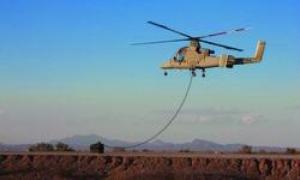The US Army is getting involved in the analysis of alternatives (AOA) being conducted by the Navy to determine the service requirements and the possibility drafting of a joint program for the vertical-takeoff-and-landing aircraft (VTOL) unmanned aircraft.
 Lockheed Marin Kaman
Lockheed Marin Kaman
Tim Owings, who is the acting program manager for the Army UAVs, explained that the army has added an additional section to the Navy-led study to determine if the requirements can be met by separate programs or a joint program. The AOA would take another six months, during this time the army would be releasing a request for information for the available VTOL aircrafts.
Two aircrafts that the Navy is currently evaluating are the BoingA160T Hummingbird and Lockheed Martin/Kaman K-Max for the unmanned supply of Marine Corps forward operating bases in Afghanistan. Another aircraft that is likely to be considered is the Northrop Grumman/Bell Fire-X. Owings mentioned that they are looking at fixed-wing aircrafts capable of vertical lift and able to endure a 1,000 pound payload for over 12 hours. He added that the strategy proposed by the army is looking at providing two quick-reaction-capability (QRC) contacts that would be evaluated for a year before launching the VTOL UAV program. Based on the evaluation one of the systems can be chosen for development and production.
The army is preparing to deploy three A160T unmanned helicopters for carrying the BAE Systems Argus-IS. The Argus-IS is an airborne surveillance sensor capable of covering a wide-area for survey which was developed for the Defense Advanced Research Projects Agency (Darpa). Apart from carrying the Argus, the helicopters would house a signals intelligence package for geolocation of targets. The flight testing is scheduled to begin in another two months. Owings stated that the army would mostly be deploying the aircrafts in Afghanistan in the second quarter of 2012.